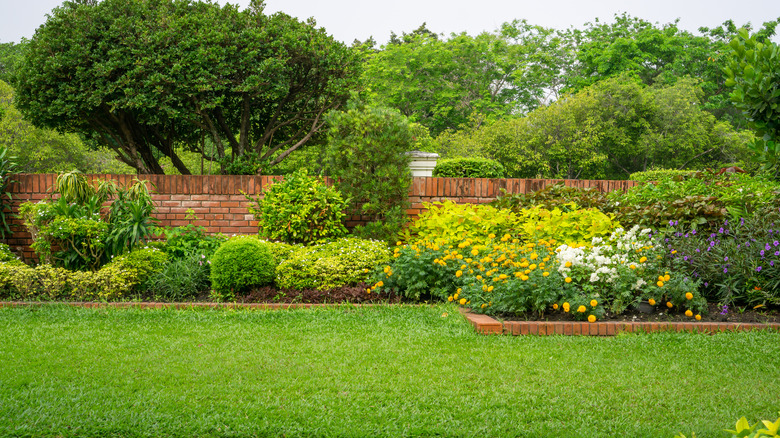Our Expert's Best Tips For Efficiently Transplanting Shrubs From Your Lawn
A good shrub can add a lot to your outdoor space, whether it provides evergreen foliage for landscaping or brings a pop of color to the mix. The right shrub can even attract birds to your yard with a thoughtful placement. But location is key: it's tough to appreciate a shrub when it's smack-dab in the middle of your lawn, and certain shrubs might better accentuate your yard when relocated.
With the proper tools and preparation, you can easily relocate an unruly shrub and ensure that it thrives in its new location. In an exclusive interview with House Blog, Eva Monheim, a horticultural consultant, Certified Arborist, and faculty at Longwood Gardens gave advice on transplanting shrubs. Monheim is also the director and producer of "The Plant a Trillion Trees Podcast." Her advice for transplanting shrubs begins with a good, solid plan: "Having a methodical method of transplanting makes each new transplant easier and will help to achieve success each time you transplant." Monheim also recommends a few critical strategies for both removing and replanting your lawn shrubs.
Removing your shrub
Eva Monheim's exclusive tips for House Blog include gathering the right materials prior to removing your established shrub. "Take care to use a sharp spade to cut through the roots about 18 to 20 inches from the base of the shrub," Monheim says. "If you do this in the fall it is ideal because new roots will form on the roots that remain on the plant and will help the plant to re-establish itself when moved in the spring." Regardless of when you begin the transplant process, after cutting through the roots, wiggle the root ball free using leverage from the spade. To make this process easier, Monheim recommends trimming or pruning the size of the above-ground plant down so that it's about ⅔ its previous size. She also advises gardeners to keep an eye out for any scraps of grass that might be growing around the base of their lawn shrubs, as they should be removed before transplanting.
Monheim also suggests having a tarp on hand to make transplanting neater, especially for gardeners working on a lawn. "Tarps make cleanup a breeze," she says. Monheim lays a tarp atop the lawn to put soil on while digging up shrubs and again when digging a new hole for her transplants. With this method, when the relocation is complete, you can simply dump any excess soil on the tarp somewhere where it won't create a muddy spot on your lawn.
Replanting your shrub
In her exclusive advice to House Blog, Eva Monheim notes that the new hole where you wish to replant your shrub should be about twice the size of the root ball. And she has pointers for improving the shrub's success once it's in its new home: "In the new hole I like mixing in some moisture crystals to help hold moisture around the roots ... They will swell up and absorb water each time it rains and will last for a good year or more helping the plant to re-establish." Monheim explains that you can also use a pre-soaked tree diaper around the base of the shrub. Once you've successfully transplanted your shrub, lightly mulch around the plant, avoiding the area closest to the base.
But relocating and transplanting the shrubs on your lawn isn't the only option. "You can also leave the shrub in place in the lawn and make an island garden," Monheim suggests. To do so, you can mark out the area for your island garden surrounding the shrub in the fall, lay brown paper followed by cardboard on the area, water it, and cover it with 3 inches of mulch. "The cardboard will break down over the winter and will be easy to poke through to plant your new garden," Monheim explains. This will allow your shrub to become a "focal point" on your lawn rather than an outlier.


